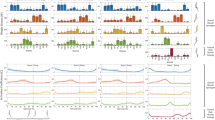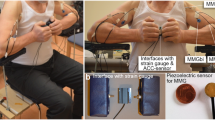Abstract
The purpose of this study was to compare the electromyographic (EMG) behavior of the triceps surae (TS), tibialis anterior (TA), quadriceps and hamstring muscles of the lower limbs during self-initiated free gait in a group of patients (n=15) with Parkinson's disease (PD), when OFF and ON L-Dopa, with that of normal controls. When OFF L-Dopa, we observed qualitative disturbances in muscle activation patterns, such as an absence or extreme reduction in TA activations in early stance or during the early and late swing phases. Other disturbances included flatter profiles of the TS activation burst at push off, and temporal alterations that included prolonged activation of the proximal muscles during the stance phase. Statistical analysis showed that the TA was the most affected muscle in most of the patients particularly during the activation burst in late swing (p<.0004). After medication (ON L-Dopa), the amplitude and timing of distal muscle activations became more similar to normal values, with the increase in EMG amplitude being dramatic in some patients. In the proximal muscles, the effects on EMG amplitude were less marked and prolonged activation often persisted even after the administration of L-Dopa.
Sommario
Lo scopo di questo studio è stato di analizzare i patterns elettromiografici (EMG) dei muscoli tricipite della sura (TS), tibiale anteriore (TA), quadricipite ed ischiocrurali, durante il cammino spontaneo ed a velocità libera, in un gruppo di soggetti (no 15) con malattia di Parkinson (PD) nelle condizioni di OFF ed ON L-Dopa e di compararli a quelli di un gruppo di controllo rappresentato da 10 soggetti sani. Nella condizione di OFF L-Dopa, abbiamo riscontrato la presenza di disturbi qualitativi sia dei profili di attivazione del TA, consistenti in assenza o estremamente ridotte attivazioni sia all'inizio della fase di appoggio che all'inizio ed alla fine della fase di oscillazione, che dei profili di attivazione del TS appiattiti in fase di spinta, nonché alcune disfunzioni temporali come prolungate attivazioni dei muscoli prossimali durante la fase di appoggio. L'analisi statistica ha mostrato che il muscolo più colpito nella maggior parte dei pazienti (p<.0004) è stato il TA durante l'approccio del piede al terreno (segmento finale della fase di oscillazione). Nella condizione di ON L-Dopa, l'ampiezza e la temporizzazione delle attivazioni dei muscoli distali (TS e TA) sono diventate più simili a quelle del gruppo di controllo. In alcuni soggetti, l'aumento dell'ampiezza EMG è stato molto marcato. Nei muscoli prossimali gli effetti sull'ampiezza EMG sono stati meno marcati e si è spesso osservato la persistenza di una prolungata attivazione anche dopo la somministrazione di L-Dopa.
Similar content being viewed by others
References
Berardelli A, Dick JPR, Rothwell JC, Day BL, Marsden CD.Scaling of the size of the first agonist EMG burst during rapid wrist movements in patients with Parkinson's disease. J Neurol Neurosurg Psychiatry, 1986; 49: 1273–79.
Blin O, Ferrandez AM, Pailhous J, Serratrice G.Dopa-sensitive and Dopa-resistant gait parameters in Parkinson's disease. J Neurol Sci, 1991; 103: 51–54.
Bonnet AM, Loria Y, Saint-Hilaire MH, Lhermitte F, Agid Y.Does long-term aggravation of Parkinson's disease result from non-dopaminergic lesions? Neurology, 1987; 37: 1939–1542.
Buchtal F, Fernandez-Ballestreros ML.Electromyographic study of the muscles of the upper arm and shoulder during walking in patients with Parkinson's disease. Brain, 1965; 88: 875–896.
Crenna P, Frigo C, Giovannini P, Piccolo I.The initiation of gait in Parkinson's disease. In: Berardelli A., Manfredi P. and Marsden C.D. eds. Motor disturbances in Parkinson's disease. II. Academic Press Limited. London, 1990: 160–173.
Dick JPR, Rothwell JC, Berardelli A, Thompson PD, Gioux M, Benecke R, Day BL, Marsden CD.Associated postural adjustments in Parkinson's disease. J. Neurol Neurosurg Psichiatry 1986; 49: 1378–1385.
Dietz V, Quintern J, Berger W.Electrophysiological studies of gait in spasticity and rigidity. Brain, 1981; 104: 431–449.
Dietz V, Berger W, Horstmann GA.Posture in Parkinson's disease: impairment of reflexes and programming. Ann Neurol, 1988; 24: 660–669.
Freund HJ, Dietz V, Witz CW, Kapp H.Discharge characteristics of single motor units in normal subjects and patients with supraspinal motor disturbances. In: Desmedt J.E. ed. New Developments in Electromyography and Clinical Neurophysiology: Basel, Switzerland: S Karger, A.G., Medical and Scientific Publishers, 1973: 242–250.
Forssberg H, Johnels B, Steg G.Is parkinsonian gait caused by a regression to an immature walking pattern? Hassler R.G. and Christ J.F., eds. Advances in Neurology. New York: Raven Press, 1984; 40: 375–379.
Grillner S, Dubuc R.Control of locomotion in vertebrate: spinal and supraspinal mechanisms. Adv Neurol, 1988; 47: 425–453.
Hallett M, Khoshbin S.A physiological mechanism of bradykinesia. Brain, 1980; 103: 301–314.
Hoehn MM, Yahr MD.Parkinsonism: onset, progression and mortality. Neurology, 1967; 17: 427–442.
Hughes JR, Bowes SG, Leeman AL, O'Neil CJA, Deshmukh AA, Nicholson PW, Dobbs SM, Dobbs RJ.Parkinsonian abnormality of foot strike: a phenomenon of ageing and/or one responsive to levodopa therapy? Br J Clin Pharmacol, 1990; 29: 179–186.
Isacsson J, Gransberg L, Knutsson E.Three dimensional electrogoniometric gait recording. J Biomech, 1986; 19: 627–635.
Knutsson E, Martensson A.Quantitative effects of L-Dopa on different types of movements and muscle tone in parkinsonian patients. Scand J Rehab Med, 1971; 3: 121–130.
Knutsson E.An analysis of parkinsonian gait. Brain, 1972; 95: 475–486.
Knutsson E, Richards CL.Different types of disturbed motor control in gait of hemiparetic patients. Brain, 1979; 102: 405–430.
Koozekanani SH, Balmaseda MT, Fatehi MT, Lowney ED.Ground reaction forces during ambulation in parkinsonism: pilot study. Arch Phys Med Rehabil, 1987; 68: 28–30.
Milner-Brown HS, Fischer MA, Weiner WH.Electrical properties of motor units in parkinsonism and a possible relationship with bradykinesia. J Neurol Neurosurg Psychiatry, 1979; 42: 35–41.
Morris ME, Iansek R, Matyas T, Summer J.The pathogenesis of gait hypokinesia in Parkinson's disease. Brain, 1994; 117: 1169–1181.
Murray MP, Sepic SB, Gardner GM, Downs WJ.Walking patterns of men with parkinsonism. American J Phys Medicine, 1978; 57: 278–295.
Murray MP, Spurr GB, Sepic SB, Gardner GM, Mollinger LA.Treadmill vs floor walking: kinematics, electromyogram, and heart rate. J Appl Physiol, 1985; 59: 87–91.
Pedersen SW, Eriksson T, Oberg B.Effects of withdrawal of antiparkinson medication on gait and clinical score in the Parkinson patient. Acta Neurol Scand, 1991; 84: 7–13.
Petajan JH, Jarcho LW.Motor unit control in Parkinson's disease and the influence of levodopa. Neurology, 1975; 25: 866–869.
Perry J.Kinesiology of lower extremity bracing. Clin Orthop Rel Res, 1974; 102: 18–36.
Richards CL, Wessel J, Malouin F.Muscle activation patterns in gait of rheumatoid arthritic patients. Physiother Can, 1985; 37: 220–228.
Ransmary G, Kunig G, Neubauer M, Wagner M, Bosch S, Kreczy-Kleedorfer B.Is the decreasing responsiveness of axial motor symptoms to L-Dopa in elderly parkinsonian patients related to age-associated nonparkinsonian pathologies? In: Narabayashi H, Nagatsu T, Yanagisawa N and Mizuno Y. Eds. Advances in Neurology, vol. 60, Raven Press, Itd, New York, 1993: 685–689.
Stern GM, Franklyn SE, Imms FJ, Prestidge SP.Quantitative assessments of gait and mobility in Parkinson's disease. J Neural Trans suppl, 1983; 19: 201–214.
Weinrich M, Koch K, Garcia F, Angel RW.Axial versus distal motor impairment in Parkinson's disease. Neurology, 1988; 38: 540–545.
Winter DA.Overall principle of lower limb support during stance phase of gait. J Biomech, 1980; 13: 923–927.
Author information
Authors and Affiliations
Additional information
This work was supported by grants from Laval University.
Rights and permissions
About this article
Cite this article
Cioni, M., Richards, C.L., Malouin, F. et al. Characteristics of the electromyographic patterns of lower limb muscles during gait in patients with Parkinson's disease when OFF and ON L-Dopa treatment. Ital J Neuro Sci 18, 195–208 (1997). https://doi.org/10.1007/BF02080464
Received:
Accepted:
Issue Date:
DOI: https://doi.org/10.1007/BF02080464




